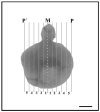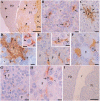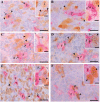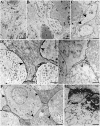Folliculostellate cells in pituitary pars distalis of male viscacha: immunohistochemical, morphometric and ultrastructural study
- PMID: 20353904
- PMCID: PMC3167288
- DOI: 10.4081/ejh.2010.e1
Folliculostellate cells in pituitary pars distalis of male viscacha: immunohistochemical, morphometric and ultrastructural study
Abstract
Folliculostellate cells (FSC) have been reported in pituitary of several mammalian species. FSC morphology and secreted substances have been instrumental to the understanding of their function. The purpose of this work was to perform an immunohistochemical, morphometric and ultrastructural study of the pituitary pars distalis FSC in adult male viscacha and to analyze their relation with hormone secreting cells. Immunohistoche-mistry and image analysis were carried out in different sectors of the gland, from the middle (sector 1) to the glandular periphery (sector 5). Transmission electron microscopy with lanthanum as electrodense tracer was used. FSC formed follicles with PAS-positive colloid inside. They expressed S-100 protein mainly in both nucleus and cytoplasm. FSC were stellate-like in shape and exhibited short cytoplasmic processes that contacted with blood vessels and endocrine cells. In addition, some follicular colloids were immunostained with anti-S-100 protein. A few FSC were immunostained with anti-glial fibrillary acidic protein (GFAP) and anti-vimentin. The morphometric parameters analyzed (percentages of S-100-positive total, cellular and colloidal areas) increased from sector 1 to sector 3 and then decreased to sector 5. Hormone secreting cells, mainly lactotrophs, gonadotrophs and corticotrophs were associated with FSC and follicles. The ultrastructural study demonstrated that FSC developed junctional complexes and desmosomes between their lateral membranes. Lanthanum freely penetrated the spaces between granulated cells and FSC, but did not penetrate into the follicular lumen.
In conclusion: 1) the differential expression of S-100 protein, GFAP and vimentin may indicate different physiological stages of FSC; 2) the expression of these proteins suggests a neuroectodermic origin of these cells; 3) FSC spatial distribution, association with endocrine cells, and the generation of an intercellular communication network suggest that FSC are involved in the pituitary pars distalis paracrine regulation of the viscacha.
Figures






Similar articles
-
Immunohistochemical and morphometric study of pituitary pars distalis folliculostellate cells of nonpregnant and pregnant viscachas.Biotech Histochem. 2013 May;88(3-4):161-9. doi: 10.3109/10520295.2012.750737. Epub 2012 Dec 17. Biotech Histochem. 2013. PMID: 23244236
-
Pituitary pars intermedia of male viscacha (Lagostomus maximus maximus): a morphometric study of seasonal and age-related changes in immunohistochemistry.Cells Tissues Organs. 2009;190(4):219-29. doi: 10.1159/000204751. Epub 2009 Feb 23. Cells Tissues Organs. 2009. PMID: 19246879
-
Effect of the photoperiod and administration of melatonin on folliculostellate cells of the pituitary pars distalis of adult male viscacha (Lagostomus maximus maximus).Acta Histochem. 2011 Oct;113(6):640-6. doi: 10.1016/j.acthis.2010.08.003. Epub 2010 Sep 15. Acta Histochem. 2011. PMID: 20828800
-
Folliculo-stellate cells of the human pituitary: a type of adult stem cell?Ultrastruct Pathol. 2002 Jul-Aug;26(4):219-28. doi: 10.1080/01913120290104476. Ultrastruct Pathol. 2002. PMID: 12227947 Review.
-
Folliculo-stellate cells and intercellular communication within the rat anterior pituitary gland.Microsc Res Tech. 1997 Oct 15;39(2):138-49. doi: 10.1002/(SICI)1097-0029(19971015)39:2<138::AID-JEMT5>3.0.CO;2-H. Microsc Res Tech. 1997. PMID: 9361265 Review.
Cited by
-
Histochemistry through the years, browsing a long-established journal: novelties in traditional subjects.Eur J Histochem. 2010 Dec 16;54(4):e51. doi: 10.4081/ejh.2010.e51. Eur J Histochem. 2010. PMID: 21263750 Free PMC article.
-
Age-Related Hormones Changes and Its Impact on Health Status and Lifespan.Aging Dis. 2023 Jun 1;14(3):605-620. doi: 10.14336/AD.2022.1109. Aging Dis. 2023. PMID: 37191429 Free PMC article. Review.
-
Hypophysial angiogenesis decodes annual time and underlies physiological adaptation to seasonal changes in the environment.J Exp Zool A Ecol Integr Physiol. 2022 Dec;337(9-10):939-951. doi: 10.1002/jez.2639. Epub 2022 Jul 18. J Exp Zool A Ecol Integr Physiol. 2022. PMID: 35844178 Free PMC article.
-
Loss of the NHE2 Na+/H+ exchanger in mice results in dilation of folliculo-stellate cell canaliculi.J Biomed Biotechnol. 2011;2011:510827. doi: 10.1155/2011/510827. Epub 2011 Jan 10. J Biomed Biotechnol. 2011. PMID: 21274460 Free PMC article.
-
Expression of aromatase in radial glial cells in the brain of the Japanese eel provides insight into the evolution of the cyp191a gene in Actinopterygians.PLoS One. 2012;7(9):e44750. doi: 10.1371/journal.pone.0044750. Epub 2012 Sep 5. PLoS One. 2012. PMID: 22957105 Free PMC article.
References
-
- Marin F, Stefaneanu L, Kovacs K. Folliculostellate cells of the pituitary. Endocr Pathol. 1991;2:180–92. - PubMed
-
- Allaerts W, Vankelecom H. History and perspectives of pituitary folliculo-stellate cell research. Eur J Endocrinol. 2005;153:1–12. - PubMed
-
- Luziga C, Yoshimi Y, Yoichiro H, et al. Phagocytotic removal of apoptotic endocrine cells by folliculostellate cells and its functional implications in clusterin accumulation in pituitary colloids in helmeted guinea fowl (Numida meleagris) Acta Histochem. 2006;108:69–80. - PubMed
-
- Luziga C, Kipanyula MJ, Mbassa G, Koichi M. Colloid in the anterior pituitary of helmet guinea fowl (Numida meleagris galeata): morphometric analysis and pattern of occurrence in relation to apoptosis. Vet Res Commun. 2009;33:681–91. - PubMed
-
- Devnath S, Inoue K. An insight to pituitary folliculo-stellate cells. J Neuroendocrinol. 2008;20:687–91. - PubMed
Publication types
MeSH terms
Substances
LinkOut - more resources
Full Text Sources
Miscellaneous

